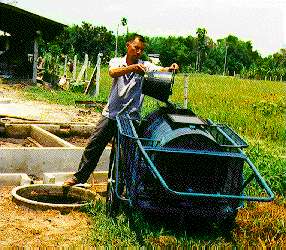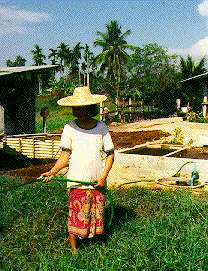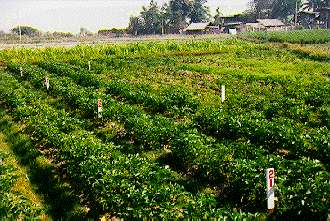Sludge Management
Overview
To retain the maximum fertilizing quality of digested slurry, i.e. it's nitrogen content, it should be stored only briefly in liquid form in a closed pit or tank and then applied on the fields. Preferably, it should be dug into the soil to prevent losses on the field.
Sludge Storage
Sludge storage is normally effected according to one or the other of the following three techniques:
Liquid Storage
The effluent outlet of the biogas system leads directly to a collecting tank. Loss of liquid due to evaporation or seepage must be avoided. Just before the sludge is needed, the contents of the tank is thoroughly agitated and then filled into a liquid manure spreader or, if it is liquid and homogenous enough, spread by irrigation sprinklers. The main advantage of liquid storage is that little nitrogen is lost. On the other hand, liquid storage requires a large, waterproof storage facility entailing a high initial capital investment.
The practice of spreading liquid slurry also presents problems in that not only storage tanks are needed, but transport vessels as well. The amount of work involved depends also on the distance over which the slurry has to be transported. For example, loading and transporting one ton of slurry over a distance of 500 m in an oxcart (200 kg per trip) takes about five hours. Distributing one ton of slurry on the fields requires another three hours.
Drying
It is only possible to dry digested sludge as long as the rate of evaporation is substantially higher than the rate of precipitation. The main advantage of drying is the resultant reduction in volume and weight. Drying can also make the manual spreading easier. The cost of constructing shallow earthen drying basins is modest. On the other hand, drying results in a near-total loss of inorganic nitrogen (up to 90%) and heavy losses of the total nitrogen content (approx. 50%).
Composting
Nitrogen losses can be reduced by mixing the digested sludge with organic material. As an additive to crop residues for composting, biogas sludge provides a good source of nitrogen for speeding up the process. At the same time it enriches the compost in nitrogen, phosphorus and other plant nutrients. Furthermore, the aerobic composting process, by it's temperature, effectively destroys pathogens and parasites that have survived the anaerobic digestion treatment. The ready-made compost is moist, compact and can be spread out by simple tools. With most available transport facilities in developing countries, it is easier to transport than liquid manure.
Composition of Sludge
Process of Biomethanation
Anaerobic digestion draws carbon, hydrogen and oxygen from the substrate. The essential plant nutrients (N,P,K) remain largely in the slurry. The composition of fertilizing agents in digested slurry depends on the fermented substrate and can, therefore, vary within certain limits.
For an average daily substrate feed rate of 50 kg per livestock unit (LSU = 500 kg live weight) and a daily gas yield of 1 m3 biogas/LSU, the mass of the influent substrate will be reduced by some 2% through the process of bio-methanation (volumetric weight of biogas: 1.2 kg/m3).
Viscosity
The viscosity of the slurry decreases significantly, because the amount of volatile solids is reduced by about 50% in the course of a stable process of fermentation. In addition, the long carbon chains (cellulose, alcohol and organic acids) are converted into short carbon chains (see also under Microbiological Methanation).
Odor
The effluent sludge is much less odorous than the influent substrate (dung, urine). Given sufficient retention time, nearly all odorous substances are completely digested.
Nutrients
The fertilizing properties of digested slurry are determined by how much mineral substances and trace elements it contains. In tropical soil, the nitrogen content is not necessarily of prime importance - lateritic soils, for example, are more likely to suffer from a lack of phosphorus. All plant nutrients such as nitrogen, phosphorous, potassium and magnesium, as well as the trace elements essential to plant growth, are preserved in the substrate. The C/N ratio is reduced by the simultaneous loss of carbon, thus generally improving the fertilizing effect of the digested sludge, since a lower C/N ratio (ca. 1:15) has a favorable phytophysiological effect. Table B4 lists the approximate nutrient contents of various substrates, whereby it should be remembered that the actual values may vary considerably, depending on fodder eaten by the animals.
The phosphate content ("P2O5" is the form of phosphorous available for plants) is not affected by fermentation. Some 50% of the total phosphorous content is available for plants in the form of phosphate. Similarly, anaerobic fermentation does not alter the rate of plant-available potassium (75 to 100% of the total potassium).
Nitrogen Compounds
In contrast to the above nutrients, however, some nitrogen compounds undergo modification during anaerobic digestion. About 75% of the nitrogen contained in fresh manure is built into organic macromolecules, and 25% is available in mineral form as ammonium. The effluent sludge contains roughly 50% organic nitrogen and 50% mineral nitrogen. The stated levels can only be taken as approximate values, since they vary widely, depending on the type of animal involved, the fodder composition, the retention time, etc. Mineral nitrogen can be directly assimilated by plants, while organic nitrogen compounds must first be mineralized by microorganisms in the soil.
Fertilizing Effect of Effluent Sludge
Digested slurry is most effective when it is spread on the fields shortly before the beginning of the vegetation period. Additional doses can be given periodically during the growth phase, with the amounts and timing depending on the crop in question. For reasons of hygiene, however, leafy vegetables should not be top-dressed.
Assuming that the soil should receive enough fertilizer to replace the nutrients that were extracted at harvesting time, each hectare will require an average dose of about 33 kg N, 11 kg P2O5 and 48 kg K2O to compensate for an annual yield of 1-1.2 tons of, for example, sorghum or peanuts. Depending on the nutritive content of the digested slurry, 3-6 t of solid substance per hectare will be required to cover the deficit. For supply with a moisture content of 90%, the required quantity comes to 30-60 t per hectare and year. That roughly corresponds to the annual capacity of a 6-8 m3 biogas plant.
Caustic Effect on Grassland
Digested sludge has much less caustic effect on grassland than does fresh liquid manure. Effluent sludge is also very suitable for use as a "top-dressing" whenever its application is deemed to have the best fertilizing effect.
Eutrophication
Serious ecological damage can be done by applying fertilizing sludge in excessive amounts or at the wrong time, namely when the assimilative capacity of the plants is low. Nitrogen "washout" can cause over-fertilization (eutrophication) of ground and surface water.
Further Information






















